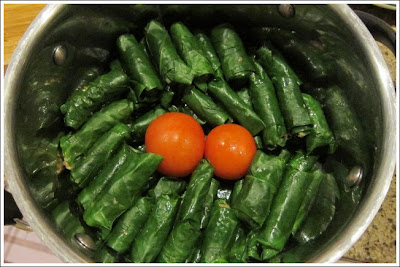Sarma or Dolma?
These are not quite the same although the names are sometimes used interchangeably. These made from Swiss Chard leaves are called sarma because they are rolled. Cabbage and vine leaves can be used in the same way and strictly speaking are also sarma but you do hear them being called dolma. The term dolma really refers to vegetables eg courgettes, aubergines, tomatoes, and peppers which can be hollowed out and stuffed. I associate these with summer when those vegetables are plentiful.
I have stuffed a good many vegetables in my time and rolled a great many sigara böreği, those little cigarette-shaped börek made with white cheese and parsley, so making these was not the challenge it might have been. As with much of Turkish cooking, the preparation can be time-consuming but the end result is always tasty!
 |
| this is how it's sold |
Confession time: pazı is a new vegetable for me! Spinach has always been my winter vegetable of choice but the attractive bright green of these leaves finally persuaded me to buy a bunch. I was inordinately proud of myself as these sarma worked out beautifully. My husband polished off the lot leaving me wondering if he had been missing them all these years!
Ingredients for Meat-Stuffed Chard Rolls/Etli Pazı Sarması
Serves 6
2 bunches large leaf chard/pazı
300 gr minced lamb (I actually used beef)
½ cup rice
3 onions, finely chopped
4 tbsp cooking oil
4 tomatoes (2 for the stuffing, 2 for cooking in the pan)
small handful each of chopped parsley and dill
small handful each of chopped parsley and dill
½ tsp pepper
½ tsp flaked red pepper
1 ½ tsp salt
2 cups hot water
Method
· Cut and discard the stems of the chard leaves and then wash the leaves. In order to soften them in preparation for rolling, boil up a pan of water and put them in, a few at a time, and immediately remove and plunge into a basin of cold water. This way the bright green colour is preserved.
· Take the chopped onion and cook gently in the cooking oil till soft.
· For the stuffing: wash and drain the rice and put into a large bowl. Add the cooked onion, mince, salt, pepper, flaked red pepper, chopped parsley and dill, plus grated tomatoes and mix together with your hands.
· Take one chard leaf and spread it out on a hard surface. Cut out the tough central vein with a sharp knife so you have 2 halves. Make sure the shiny side of the leaf is face-down. Place a small amount of the stuffing on one half and roll up, folding over the ends first. Use your fingers to roll it up tightly.
· Take your pan and first spread one or two more battered leaves on the bottom. Place the remaining 2 tomatoes in the middle and then arrange the sarma next to each other in layers. Pour the hot water over them and then cover with a plate (see picture).
· Bring to the boil then lower the heat and cook for about 30 minutes. When time is up, they can rest quite happily and be reheated if necessary. Serve with garlic yogurt and a sprinkle of flaked red pepper.
Tips
1. If the leaf is small, cut out the vein and then overlap one half with the other half. This will make it easier to roll.
2. There is a tendency to put too much stuffing on each half which then makes it impossible to roll. Some of the rolls will be very small but that’s fine!
3. A friend of mine says her mother-in-law always mixed a little tomato paste/salça in the hot water at the end which sounds like a good idea.
4. If you have a little bit of stuffing left over, roll it into walnut-sized balls and place them in the pan. They will swell up and be tiny hedgehog meatballs.
5. These sarma are truly delicious and so authentically Turkish! But you wouldn’t want to make them for a large family unless you had a trusty helper to assist with the rolling!
 |
| afiyet olsun! |
A little aside about the spelling: you may have noticed that sometimes there is a dot on the Turkish letter i and sometimes not, it’s not just me! They are two different letters and produce different sounds. İ with a dot is pronounced like the i in ‘bit’ while the dotless ı is pronounced like the er in water (English pron). Their usage depends on vowel harmony but we won’t go into that here! The final ‘si’ or ‘sı’ that you may have noticed on the end of some of the names of these Turkish recipes, indeed like the one above, is a kind of genitive. Just in case you were wondering!








No comments:
Post a Comment